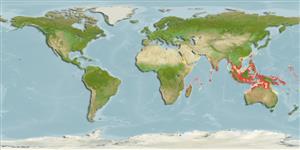>
Batrachoidiformes (Toadfishes) >
Batrachoididae (Toadfishes) > Halophryninae
Etymology: Allenbatrachus: Composed from Jerry Allen an Australian taxonomist + Greek, batrachos = frog (Ref. 45335).
More on author: Linnaeus.
Environment: milieu / climate zone / depth range / distribution range
Écologie
marin; saumâtre démersal; pH range: 7.8 - 8.5; amphidrome (Ref. 51243). Tropical; 23°C - 28°C (Ref. 2059)
Indo-West Pacific. Recorded from the Persian Gulf (Ref. 80050). Known from the Mekong delta (Ref. 12693).
Taille / Poids / Âge
Maturity: Lm ? range ? - ? cm
Max length : 30.0 cm TL mâle / non sexé; (Ref. 4833)
Épines dorsales (Total) : 3; Rayons mous dorsaux (Total) : 18 - 22; Rayons mous anaux: 16 - 17; Vertèbres: 26 - 27.
Occurs in bottom areas mainly in the coastal waters. Euryhaline (Ref. 12041). Found in the sea and estuarine areas (Ref. 4833). Occurs in estuaries over muddy bottoms (Ref. 12693).
Life cycle and mating behavior
Maturities | Reproduction | Spawnings | Egg(s) | Fecundities | Larves
Greenfield, D.W., 1997. Allenbatrachus, a new genus of Indo-Pacific toadfish (Batrachoididae). Pac. Sci. 51(3):306-313. (Ref. 26916)
Statut dans la liste rouge de l'IUCN (Ref. 130435)
Utilisations par l'homme
Pêcheries: sans intérêt
Outils
Articles particuliers
Télécharger en XML
Sources Internet
Estimates based on models
Preferred temperature (Ref.
123201): 26.4 - 29.1, mean 28.3 °C (based on 1238 cells).
Phylogenetic diversity index (Ref.
82804): PD
50 = 0.6250 [Uniqueness, from 0.5 = low to 2.0 = high].
Bayesian length-weight: a=0.00389 (0.00180 - 0.00842), b=3.12 (2.94 - 3.30), in cm total length, based on all LWR estimates for this body shape (Ref.
93245).
Niveau trophique (Ref.
69278): 3.5 ±0.5 se; based on size and trophs of closest relatives
Résilience (Ref.
120179): Milieu, temps minimum de doublement de population : 1,4 à 4,4 années (Preliminary K or Fecundity.).
Fishing Vulnerability (Ref.
59153): Low vulnerability (20 of 100).
